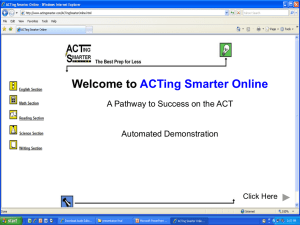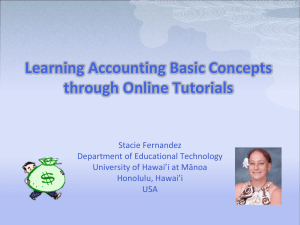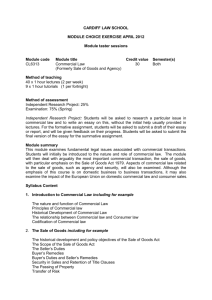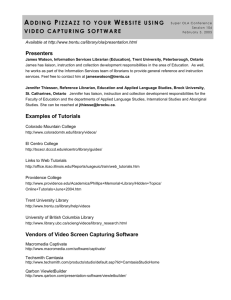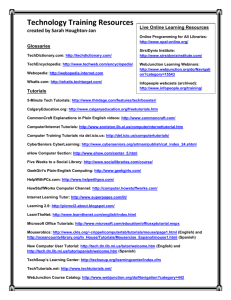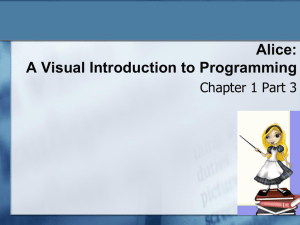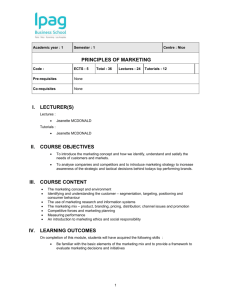Institutionalizing reform in introductory physics
advertisement
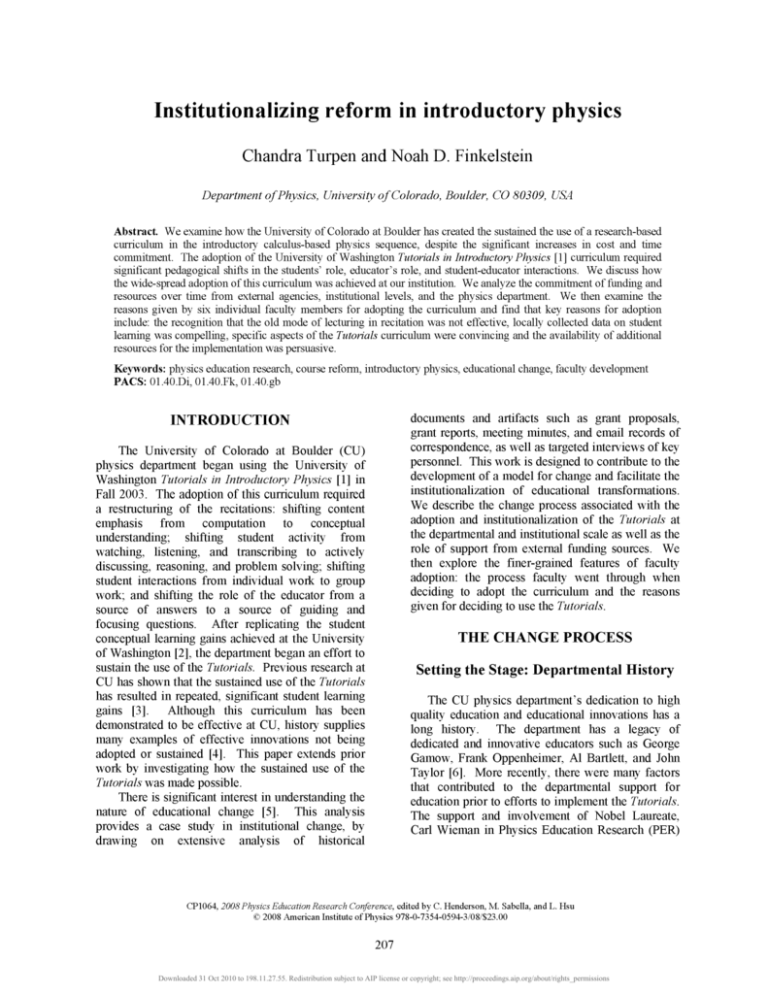
Institutionalizing reform in introductory physics Chandra Turpen and Noah D. Finkelstein Department of Physics, University of Colorado, Boulder, CO 80309, USA Abstract. We examine how the University of Colorado at Boulder has created the sustained the use of a research-based curriculum in the introductory calculus-based physics sequence, despite the significant increases in cost and time commitment. The adoption of the University of Washington Tutorials in Introductory Physics [1] curriculum required significant pedagogical shifts in the students' role, educator's role, and student-educator interactions. We discuss how the wide-spread adoption of this curriculum was achieved at our institution. We analyze the commitment of funding and resources over time from external agencies, institutional levels, and the physics department. We then examine the reasons given by six individual faculty members for adopting the curriculum and find that key reasons for adoption include: the recognition that the old mode of lecturing in recitation was not effective, locally collected data on student learning was compelling, specific aspects of the Tutorials curriculum were convincing and the availability of additional resources for the implementation was persuasive. Keywords: physics education research, course reform, introductory physics, educational change, faculty development PACS: 01.40.Di, 01.40.Fk, 01.40.gb documents and artifacts such as grant proposals, grant reports, meeting minutes, and email records of correspondence, as well as targeted interviews of key persormel. This work is designed to contribute to the development of a model for change and facilitate the institutionahzation of educational transformations. We describe the change process associated with the adoption and institutionahzation of the Tutorials at the departmental and institutional scale as well as the role of support from external funding sources. We then explore the finer-grained features of faculty adoption: the process faculty went through when deciding to adopt the curriculum and the reasons given for deciding to use the Tutorials. INTRODUCTION The University of Colorado at Boulder (CU) physics department began using the University of Washington Tutorials in Introductory Physics [1] in Fall 2003. The adoption of this curriculum required a restructuring of the recitations: shifting content emphasis from computation to conceptual understanding; shifting student activity from watching, hstening, and transcribing to actively discussing, reasoning, and problem solving; shifting student interactions from individual work to group work; and shifting the role of the educator from a source of answers to a source of guiding and focusing questions. After replicating the student conceptual learning gains achieved at the University of Washington [2], the department began an effort to sustain the use of the Tutorials. Previous research at CU has shown that the sustained use of the Tutorials has resulted in repeated, significant student learning gains [3]. Although this curriculum has been demonstrated to be effective at CU, history supphes many examples of effective irmovations not being adopted or sustained [4]. This paper extends prior work by investigating how the sustained use of the Tutorials was made possible. THE CHANGE PROCESS Setting the Stage: Departmental History The CU physics department's dedication to high quality education and educational irmovations has a long history. The department has a legacy of dedicated and irmovative educators such as George Gamow, Frank Oppenheimer, Al Bartlett, and John Taylor [6]. More recently, there were many factors that contributed to the departmental support for education prior to efforts to implement the Tutorials. The support and involvement of Nobel Laureate, Carl Wieman in Physics Education Research (PER) There is significant interest in understanding the nature of educational change [5]. This analysis provides a case study in institutional change, by drawing on extensive analysis of historical CP1064, 2008 Physics Education Research Conference, edited by C. Henderson, M. Sabella, and L. Hsu © 2008 American Institute of Physics 978-0-7354-0594-3/08/$23.00 207 Downloaded 31 Oct 2010 to 198.11.27.55. Redistribution subject to AIP license or copyright; see http://proceedings.aip.org/about/rights_permissions and reform greatly added to departmental awareness and respect for the field. In 2001, the initial use of personal response systems and Peer Instruction began in CU physics. Within two years, Peer Instruction became commonly used by all faculty members in the large introductory physics courses. In 2002, the physics department faculty began to gather for brown bag discussions in education. These meetings, held over lunch, were a forum for faculty in the department to discuss relevant issues in education in an informal manner. A sample of discussion topics during the first year included: educational technologies and curricula being developed at other institutions, sharing of locally developed course materials, and strategies for teaching to a broad spectrum of student backgrounds [7]. In 2002, the physics department also granted its first PhD in the field of PER. This was followed shortly after with the department voting to commit a tenure line to physics education research, and formally establish a PER research group. All of these efforts set the stage for the department to adopt and sustain the use of the Tutorials. #0554616 (which researches and partially supports the program). Departmental Change After the initial implementation, the CU physics department gradually committed additional resources to support the Tutorials. These resources began after the Tutorials were first used in more traditional classroom settings. After some demonstration of the effectiveness of this curriculum, the department committed dedicated classroom space, which was taken out of a larger student laboratory area. The department purchased larger tables with moveable chairs and equipment for laboratory activities, using money from the course fees fund. These resources allowed the Tutorials to operate in a dedicated space that more easily facilitated group interactions. Shortly after the commitment of these resources, the department decided to systematically institute team teaching assignments which placed two professors collaboratively teaching each of the large introductory courses, including courses implementing Tutorials. The intention behind introducing team teaching was to lower the load on individuals so that they will have more time to: reflect on their teaching, prepare for teaching, and do the work necessary for implementing innovative teaching strategies [7]. While the division of labor varied across teaching pairs, often one professor would take responsibility for the lecture periods (lead), while the other would manage the TAs, recitation sections and course logistics (secondary). External Funding Sources The initial implementation of the Tutorials was made possible by the interest and energy of Professor Steven Pollock, the initial implementer of the curriculum at CU, but could not have succeeded without the support of the STEM-TP Grant (NSF#03022I34). The STEM-TP grant began the CU Learning Assistant (LA) program. This program had as its goals: I) to increase the quantity and quality of STEM K-I2 teachers by recruiting science majors for early educational experiences in undergraduate courses and 2) to transform the way science departments teach science at the undergraduate level. These undergraduate LAs provided the critical infrastructure to increase the teacher to student ratio required for small group work as recommended by the Tutorial designers. The evaluation, sustained use, and expansion of the Tutorials was accomplished with the support of Colorado PhysTEC Grant from the APS, AAPT, and AIP as well as CCLI Grant (NSF #0410744). These two grants helped to expand and to bridge funding from the STEM-TP grant to the sustained support of the LA program. Currently, the LA program is supported from: the CU physics department, the University, private donors, and an NSF TPC grant The physics department continued its brown bag discussions and its partnership with the Learning Assistant program. In Fall 2004, to support the development of the PER group and the efforts to recruit physics majors to teaching, the physics department added an elective course in Teaching and Learning Physics [8] which routinely placed undergraduate and graduate students as LAs in the Tutorial courses. Recently (2008), department also awarded tenure to its first professor in the field of Physics Education Research. In Spring 2005, the Teaching Evaluation Committee in the department decided to further modify the peer teaching evaluation criteria. These modifications placed increasing emphasis on student engagement and coordination of course learning goals and course activities. These evaluations were designed to recognize innovative efforts using Peer Instruction, Tutorials and student-centered reform. 208 Downloaded 31 Oct 2010 to 198.11.27.55. Redistribution subject to AIP license or copyright; see http://proceedings.aip.org/about/rights_permissions - PhysTEC Grant: AAPT. APS, & AIP -CCLIGiaut:NSFS0410744 II - SrEM-TP Grant: NSF ii!0302134 + I I - LA-TESI Grant: NSF #0554616 •* Jan 2004 7:—h ll 11" "-a —I Provost Fimdiog Fundmg &>m the [>ea]i ruuding iiwa Iht Dean •f Alts & Sciences "— of ArrM& ScieDces —^ - DeparmieDtal Kesources: Team Teaching Assignments - Departmental Resoiircet: Cla&sroom Space Comnutted Departmental Course Fees: Tables, Chairs, & Laboratory' Equipment Jan 2007 Lin 200^ Jan 20Li6 Jaii200S ^ 1 t ' PI —*•' P2 "' ^ P2 14 —I- 1—14 ' •• W T5 -D • -El • ' . 14 PI • .. •- —I- -14 • -T4 17 B . ' PI 16 ••^ -18 -17 15 12 . • FIGURE 1: Timeline of Institutional History: Funding, Resources, & Individuals-In the professor involvement panel the abbreviated codes for faculty can be interpreted as follows: P: Physics Education Research (PER) Faculty; I: Informed, familiar with physics education research results; T: Traditional, has not frequently participated in departmental PER-activities. For additional details see Ref [2]. In each team teaching pair, the lecture professor is placed above the second, recitation professor. the Tutorials is distributed throughout the department rather than left to a specific group. This alternative model requires buy-in from the faculty to agree to implement the Tutorials as part of their teaching assignment. Over the last ten semesters implementing the Tutorials, 14 different faculty members have implemented these reforms, only two of whom are PER faculty. The three-semester break from using the Tutorials in the Mechanics course is due both to faculty choice and to the lack of institutional support: i.e. insufficient funds to pay LAs [3]. We now turn to investigate how non-PER faculty members, new to teaching with the Tutorials, decided to adopt the Tutorials and the reasons they give for adoption. Institutional Change As the physics department showed increasing commitment to sustaining the Tutorials, the university began to support these efforts as well, see Figure 1. In the sixth semester of using the Tutorials (Fall 2006), the Dean of Arts and Sciences began to commit intermittent funds to support the use of the Tutorials (supporting roughly 20% of the LAs). The physics department also partnered with the Faculty Teaching Excellence Program (FTEP) and the Graduate Teacher Program (GTP). The partnership with FTEP provided summer support for faculty research on course transformations and development of new course materials (beginning in 2003). The GTP program helped to support a lead graduate teacher to mentor other teaching assistants and occasionally assist with Tutorial preparation meetings and equipment set-up. In Fall 2007, the Provost along with the Dean of Arts and Sciences and the School of Education committed funding for these efforts and it appears that this support will continue into the foreseeable future. This commitment was spurred in part by a significant ($I20K) private donation to the LA program, along with concerted lobbying efforts of LA program Pis. The decision process We interviewed six faculty members prior to their first involvement in implementing the Tutorials. Of these six professors, four felt personally involved in the decision to use the Tutorials curriculum (12,16, T5, 15), see lower panel of Figure I. The other two faculty members (T4, 17) expressed that they were not involved in deciding to use the curriculum, but had defaulted to the decision of the other instructor in the team-teaching pair. In one case (T4), the decision was passed over to the lecture professor because the recitation professor perceived the course as primarily the responsibility of the lecture professor. In the second case (17), the lecture professor was not a permanent faculty member and did not express awareness about how decisions like these were made. It appears that in this instance the recitation professor (13) alone chose to adopt the Tutorials. Of the four professors that felt personally involved in the decision to adopt the Tutorials, three (16, T5, 15) explicitly expressed that they had decided jointly with their team-teaching partner. Through these interview discussions it became clear that four out of six of the FACULTY CHOICE OF ADOPTION While the commitment of funding and resources were necessary, the Tutorials curriculum could not be sustained without the involvement of many professors. At CU, curricular decisions are not designated by the department, nor decided through a committee process. Curricular decisions fluctuate based on the availability of resources and the inclinations of the professors assigned to the course. To sustain the use of the Tutorials, CU adopted a different model from the Tutorial authors. In the CU case, the responsibility for 209 Downloaded 31 Oct 2010 to 198.11.27.55. Redistribution subject to AIP license or copyright; see http://proceedings.aip.org/about/rights_permissions professors preparing to use the Tutorials had not looked at the actual curricular activities prior to deciding to use the curriculum. departmental norm and are perceived by some faculty as an integral part of supporting student learning. As one professor states, "I think that without the Tutorials there'd be a huge vacuum that would be impossible to fill from the lectures. They've become in my mind pretty much part of physics 1, [and] physics 2... So it would be hard for me to imagine not having them." (14, following four semesters of using the Tutorials.). At least to this point it appears that the Tutorials have stuck at CU. We describe a sufficient, but not a necessary criterion for institutional change. From this analysis we observe the following three elements may be instrumental for sustaining change: 1) Address and coordinate multiple levels of the educational system (individuals, department, and institution) 2) Develop local stmctures that support reflective practice of faculty-the sharing of course materials and assessment results 3) Dedicate infrastructure resources to support the change process. Although these factors emerge as important, additional case studies across institutions are needed to fully characterize the critical features of institutional change. Reasons given for adoption The interview data from the four professors engaged in the decision-making process were transcribed and coded for instances where each professor mentioned the Tutorials or the decision to adopt the Tutorials. Here we identify the key reasons that faculty members give for adopting the Tutorials: the old model of lecturing during recitations is ineffective (n=3), the argument made by Professor PI about the success of the Tutorials based on local learning gains data was compelling (n=3), the structure of the Tutorials relieves teaching pressures from under-prepared TAs (n=2), specific pedagogical aspects of the curriculum, e.g. Use of peer discussion, and attention to specific student misconceptions (n=2). Help and resources (LAs and additional faculty) were readily available for implementing the Tutorials (n=l). There are a variety of potentially significant implications of these reasons faculty give for curriculum adoption [9]. Firstly, in our interview data there is no mention of data from other institutions or nationally. One professor exphcitly stated that he was not aware of data from the University of WA, but was aware of data on the Tutorials collected locally. The importance of local data may be particularly important in thinking about the adoption process at other institutions. Faculty members at other institutions may not be as convinced by data that are non-local. Secondly, we believe that the additional resources available for implementing the Tutorials may influence professors' decision-making process and willingness to participate. Faculty members are asked to decide about whether they would like LAs before they are exphcitly faced with designing their course for that semester. In this sense the question comes early in the professor's thinking about the course and is phrased as "would you like us to find LAs for you in order to teach with the Tutorial curriculum?" The order of these considerations is less about convincing faculty to use the Tutorials and has more to do with the practicality of finding LAs. This timing may have important imphcations for the adoption process. ACKNOWLEDGMENTS We acknowledge the generous contributions of professors in the CU physics department. Without their willingness to openly discuss their teaching practices and pedagogical decisions, this work could not be done. We would also like to thank the PER group at CU. In addition to support referenced through out the article, NSF CAREER (REC #0448176), supported these analyses. REFERENCES 1. L.C. McDermott and P.S. Schaffer, Tutorials in Introductory Physics. (Prentice Hall, 1988). 2. N.D. Finkelstein and S.J. Pollock, Phys. Rev. STPhys. Educ. Res. 1. 010101 (2005) 3. S.J. Pollock andN.D. Finkelstein,P/jj'i. Rev. STPhys. £rfMc. i?ei. 4. 010110 (2008). 4. E.M. Rogers, Diffusion ofInnovations. (The Free Press, 1995). 5. See NSF-funded conference to develop change models, http: //www. wmich. edu/science/facilitating-change/ 6. S.J. Pollock and K. Perkins, APS Fed Newsletter (Spring 2004). 7. Brown Bag Discussions minutes can be found at http://www.colorado.edu/physics/EducationIssues/resour ces/brownbags.htm 8. N. D. Finkelstein, Journal of College Science Teaching, 33(1), 37-41,(2003). 9. C. Henderson and M. Dancy, Am. J. Phys. 76, 2 (2008). C. Henderson and M.H. Dancy, P/jyx Rev. STPhys. Educ. Res. 3, 020102 (2007). CONCLUSIONS As a result of this change process, there is some evidence that the Tutorials have been accepted as the 210 Downloaded 31 Oct 2010 to 198.11.27.55. Redistribution subject to AIP license or copyright; see http://proceedings.aip.org/about/rights_permissions
